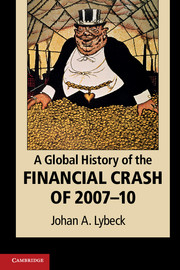Book contents
- Frontmatter
- Contents
- List of figures
- List of tables
- Preface
- Acknowledgments
- Abbreviations
- 1 Introduction
- 2 Financial crises in the USA and Europe, but not in Asia
- 3 Could today’s financial crisis have been foreseen?
- 4 The US housing market and the subprime crisis
- 5 Securitization and derivatives spread the crisis around the world
- 6 Liquidity risk aspects of the crisis and a comparison with 1907 and 1929
- 7 Credit risk aspects of the crisis, rating and solvency
- 8 Financial crises in modern history
- 9 Worldwide changes in regulation and supervision as a result of the crisis
- 10 Outstanding issues
- Bibliography
- Index
8 - Financial crises in modern history
similarities and differences
Published online by Cambridge University Press: 05 June 2012
- Frontmatter
- Contents
- List of figures
- List of tables
- Preface
- Acknowledgments
- Abbreviations
- 1 Introduction
- 2 Financial crises in the USA and Europe, but not in Asia
- 3 Could today’s financial crisis have been foreseen?
- 4 The US housing market and the subprime crisis
- 5 Securitization and derivatives spread the crisis around the world
- 6 Liquidity risk aspects of the crisis and a comparison with 1907 and 1929
- 7 Credit risk aspects of the crisis, rating and solvency
- 8 Financial crises in modern history
- 9 Worldwide changes in regulation and supervision as a result of the crisis
- 10 Outstanding issues
- Bibliography
- Index
Summary
Let us begin this chapter with a summary of the magnitude of the major crises in order to have a “tree” onto which we may attach the later “branches” about events and explanations of causality. In , we discussed the financial crisis of 1907 and the Great Depression 1929–33 and the conclusions one could draw from these events. “Black Monday” – that is, the stock market crash of 1987 – does not deserve to be called a financial crisis, since it affected only the share market, with little or no impact on other markets or the real economy. The same goes for the dotcom crisis of 2000–2. Laeven and Valencia from the IMF have recently written an excellent comparison of 124 banking crises with systemic elements for the period 1970 to 2007. Most of these occurred in developing economies and have been contained nationally. Similarly, the 138 financial crises identified by Reinhart and Rogoff in sixty-six countries were also dominated by those in developing nations. The crises in Japan, Southeast Asia and Russia are well worth discussing, however, as well as the savings and loan crisis in the USA in the 1980s and the banking crises in the Nordic countries in the 1990s.
In , the first column indicates the main year(s) of the crisis. This does not mean that the crisis was officially pronounced over at the later date. The Swedish crisis was, for all practical purposes, over in 1993, even though the blanket guarantee from the state for all banks’ liabilities was in force until July 1996, and the Bank Support Agency was not dismantled until that very year. Similarly, the thrift crisis in the USA was over in 1991, while the Resolution Trust Corporation that handled failed thrifts was not abolished until 1995. Column 2 shows non-performing loans as a percentage of total loans at the height of the crisis. Column 3 shows the gross cost to taxpayers as a percentage of GDP, thus not including repayments to the state, as toxic assets and nationalized banks were sold back to the private sector. Column 4 shows the number of banks that were seized by the supervisory authorities, went bankrupt or were forcibly merged.
- Type
- Chapter
- Information
- A Global History of the Financial Crash of 2007–10 , pp. 280 - 311Publisher: Cambridge University PressPrint publication year: 2011



